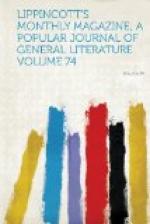The point whence the procession started—Mala Greuzin, situated at the extreme east end of Moscow—lay several miles away from the cemetery for which they were all en route; and this veritably ancient Asiatic city had to be traversed at an angle in this solemn fashion, seventy or eighty carriages following. From the beginning to the end of the prescribed route Muscovites lined the road on either side, and it is fair to add that I never beheld more respect shown even to royalty itself. All was quietness, the general expression of sympathy and respect being permitted to find vent only in excessive gesticulation and genuflection. Not a head remained covered, not a single person by whom the procession passed permitted it to do so without crossing himself several times from forehead to chest and from shoulder to shoulder.
At the first church which the procession reached, the bells of which had begun to toll—clash rather—long before it came in sight, the entire party halted. A bell was rung by one of those in advance, and then all waited. The priests and their various acolytes clustered reverently by the hearse, the followers and spectators standing at a respectful distance, but nevertheless taking part in the service. After first incensing the hearse, themselves and all around, further prayers were said and chanted: then a signal was given and all moved on again, only, however, to again pause on the route, for at every church we passed—and we must have encountered at least thirty or forty, if not more, seeing that such sacred edifices rise upon one’s view in Moscow at wellnigh every three or four minutes’ space—the ceremony was repeated. No sooner had one set of bells ceased to sound in our ears than another took its place, and again all halted, and then again all marched onward. Every window as the cortege passed along was thrown open, and figures bent forward ever and anon, enacting their wonted part in the pageant. And the pageant, be it remembered, was, after all, only one of frequent occurrence.




